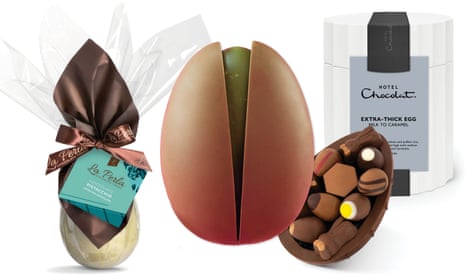At Easter, people used to get excited if theirs came with a mug and a bag of sweets but those days are over, with social media stoking demand for talking point “mega eggs” in fancy shapes and exotic flavours.
The choice is no longer just about the type: think “blonde”, “strawberry-white” or “pistachio” flavour chocolate not bog-standard milk, dark and white. There is also a race to create the thickest and, ergo, most luxurious shells.
Hotel Chocolat’s “extra thick” £29.45 eggs, for example, boast a shell so “supremely chunky” as to make dentists shudder. With the Easter holiday almost upon us, the retailer’s website has also sold out of its “lavishly thick” 1kg Ostrich eggs, which cost £85.

With the amount spent on chocolate at Easter second only to Christmas, the big players Cadbury, Mars and Nestlé have all produced super-sized eggs for about £10 that tap into what analysts said was the fastest growing part of the market in 2023.
“We’ve certainly noticed a huge increase in customers looking for special, statement Easter eggs,” says Holly Thomson, the food editor at the online retailer Sous Chef, which has sold out of £60 “giant luxury” eggs made by the Italian chocolate maker La Perla.
At 450g, these eggs are “really pretty big”, Thomson says. She suggests a “talking point mega egg” is a way of bringing people together and cheaper than a meal or night out. “Unwrapping, cracking, sharing and eating a giant Easter egg – it’s just a lovely way to have fun together,” she adds.
La Perla’s white chocolate and salted pistachio version is a chic pale green but Thomson insists the giant eggs are not gimmicks. “They’re made in Turin by a renowned chocolatier. We’ve also sold out of many of their smaller eggs … so it’s clear that our customers are looking for good chocolate but with added interest.”
With pistachio-flavoured chocolate eggs seemingly in vogue this year, Waitrose has scored a viral hit with its £14 own-brand No 1 egg that looks like a whole pistachio nut. It has sold out on the supermarket’s website and there is a burgeoning secondary market trade on eBay.

“It’s clear social media is driving the trend for premium Easter eggs, with many customers unveiling their chocolatey treats online,” says Will Torrent, Waitrose’s senior innovation chef. He adds that one video of “The Cracking Pistachio” egg has had more than 3.2m views.
After a tough period, Emily Viberg, a retail analyst at the research firm Mintel, says consumers are looking for “mood boosters”, with premium eggs tapping into optimism that the worst of the cost of living crisis is behind them.
Value is still a top priority, Viberg says, but “value does not mean finding the cheapest product … it means getting value for money”. If the artistry elevates them from “ordinary treats to works of edible art” then some shoppers will be prepared to spend more on an expensive egg amid a desire to buy products that “feel more indulgent”.
after newsletter promotion
The arrival of spring brought some good news for consumers as grocery price inflation eased to 4.5% in March, the lowest level in two years, according to the grocery industry analysts Kantar. This time last year it was 17%.
While mega eggs are certainly a “talking point” – for £65 you can buy a heavyweight (1kg) Lindt bunny to get your teeth into – you do not see large numbers of people spending this much, says Andrew Walker, the director of client service at Kantar.
The norm is to spend somewhere between £1.50 and £4 on an egg, he says. At this end of the market, eggs are getting lighter not heavier because of shrinkflation as manufacturers offset costs, not least of which is record cocoa prices.
After a period when households have been forced to cut back, Kantar’s data shows the number of eggs being bought is up on 2023. “The big shift we’re seeing is not so much people buying bigger eggs but buying more eggs,” Walker says. “More than a quarter of baskets feature four or more.”
The trend is skewed towards older shoppers, which points to gifts being bought for younger relatives. The lowest grocery inflation for two years means “people are under a little bit less pressure and therefore a bit more willing to spend”, Walker suggests.
“During the cost of living crisis people have looked to save money but also for little indulgences in their lives, and, in the grand scheme of things, the price of an Easter egg [in the supermarket] is a relatively small indulgence,” he adds.
